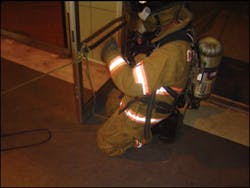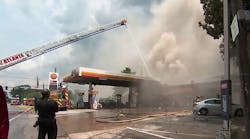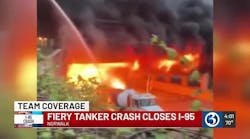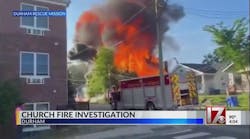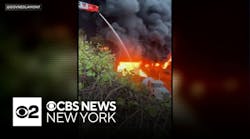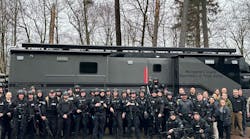The first-responding apparatus to a fire in a large commercial warehouse arrives on scene and gives a preliminary report to dispatch, stating, “On scene at a 200-by-200-foot warehouse with smoke showing. Dispatch a full first-alarm assignment to this box.†The first task that must be accomplished is to find the fire – and this may be difficult. Most fire departments have search ropes on their apparatus and should deploy them at this type of fire. The question is, does your department have standard operating guidelines (SOGs) and standardized search ropes?
In most cases, fire department SOGs for search-line deployment and use are vague. Every firefighter and officer making a search off a search rope should first know the type of search being performed. The search for fire using a search line should be treated differently than the search for life. Once water is being applied to the fire, then the search changes. If firefighters advance 100 feet into a building to search for a fire and the conditions deteriorate rapidly, they may not be able to get back out of the building or fire area before being injured.
The search for fire with a search line should take into account the need for a hoseline with water to be in place to protect the firefighters if conditions change. The hoseline should be no more than 50 feet behind the searching firefighters. If conditions change in a large commercial structure, the change will occur very quickly and water will be needed to protect the searching firefighters. An operating handline will have a stream reach of about 45 feet; therefore, 50 feet ahead of the hoseline would be the maximum distance that the search team would want to advance, depending on conditions. The search team members should keep in mind that the hose team would need to be able to apply water near them for protection. If the search team is entering a different area to search for contents and wall configurations or the layout of the building prevent the hose team from protecting the search team, then the hoseline should be brought to a point where optimal protection is offered to the search team.
Once firefighters put water on the fire and are searching for a line hazard, a completely different type of search is undertaken. Fire conditions and control of fire still must be monitored, but the fire is being extinguished and searches can proceed more safely. The difference between the two types of searches is essential to include in any search rope procedure that is used by the searching unit.
Also important in search rope SOGs is to be certain that all of the department’s search ropes are standardized. That means that all search lines are the same length and made of the same type of line so that members can recognize them in a fire building as search ropes. Any markings, knots, rings or other devices placed on the ropes also should be standardized. If members of one company encounter a search rope in a fire building, they should know that the rope will have the same markings as the ropes they trained on in their company. The uniformity of the ropes is important to ensure the safety of firefighters operating within a fire building.
A marking system is also a vital part of the search-rope standardization process. Each rope should be tagged on the outside with the unit number or designation. This will allow firefighters and officers outside the fire building to see where and which unit stretched a search line. A marking system should also be in place to allow the firefighters and search team leader inside the fire area to determine how far into the fire building they have advanced and which direction leads out of the building. This can be done in many ways, such as knots, a ring and knots, or markings placed on the rope at certain intervals. The use of a ring and knots is one of the preferred methods of marking a search line. The knots indicate the distance into the building and members can tag off and do a sweep search off the ring. The ring can go toward the fire and members trained to remember “ring of fire.â€
Sweep searches are difficult at best and require effective team leadership, rope maintenance and team discipline. In this type of search, members are directed to sweep off a search rope under the direct supervision of an officer or search team leader. The leader controls the main search line and lets members tag off the line and do a search pattern in an established direction, searching a large area. The search should be done in a certain pattern that is repeated and the searching firefighter return to the line where the officer or team leader is waiting. Search kits with retractable search line that are on the market can help, with rope maintenance.
Also required is a way to secure a search line to leave it in place for a relief unit. Whether the rope is tied off to a substantial object or secured at the last point, search will depend on the specific SOGs in place in a fire department. These searches require teamwork and a lot of manpower to complete. Searches of large areas are among the most difficult to accomplish at a fire.
During any large-area search, a safety officer should be posted outside the building to time members operating inside. If your department uses a 200-foot search line and firefighters have advanced 150 feet into a building when low-air alarms are triggered, will they be able to exit before running out of air? The safety officer should be required to mark each firefighter’s entry time and communicate the time into the structure. The officer or team leader inside should be required to communicate the distance that the team had advanced; for example, “Search team to safety. We are at the 50-foot mark on the search line. Conditions good and progress being made.†This communication will inform the safety officer and the incident commander about the team’s progress.
The safety officer also must tell the search team how long it has been in the building: “Safety to search. At 50 feet, you are in the building eight minutes.†This communication lets the search team officer or leader begin planning the team’s exit when members have been inside for about 50% of their bottles’ time.
Operations using a search line are dangerous and must be made as safe as possible by having established and standardized operating guidelines in place. This ensures the safety of the operating firefighters and officers. Different types of searches require different mindsets by the members of the search teams. Training is the key to being able to conduct a good search off a search line. When did you conduct your last search-line drill?
Michael M. Dugan, a Firehouse® contributing editor, is a 20-year veteran of the FDNY, serving as a captain of Ladder 123 in Brooklyn’s Crown Heights. He is former volunteer firefighter in the Halesite, NY, Fire Department. Dugan has been involved with the fire service for 27 years and is a hands-on-training instructor at Firehouse Expo and Firehouse World. While assigned as a firefighter in Ladder Company 43, Dugan received the James Gordon Bennett medal in 1992 and the Harry M. Archer Medal in 1993, the FDNY’s highest awards for bravery.
